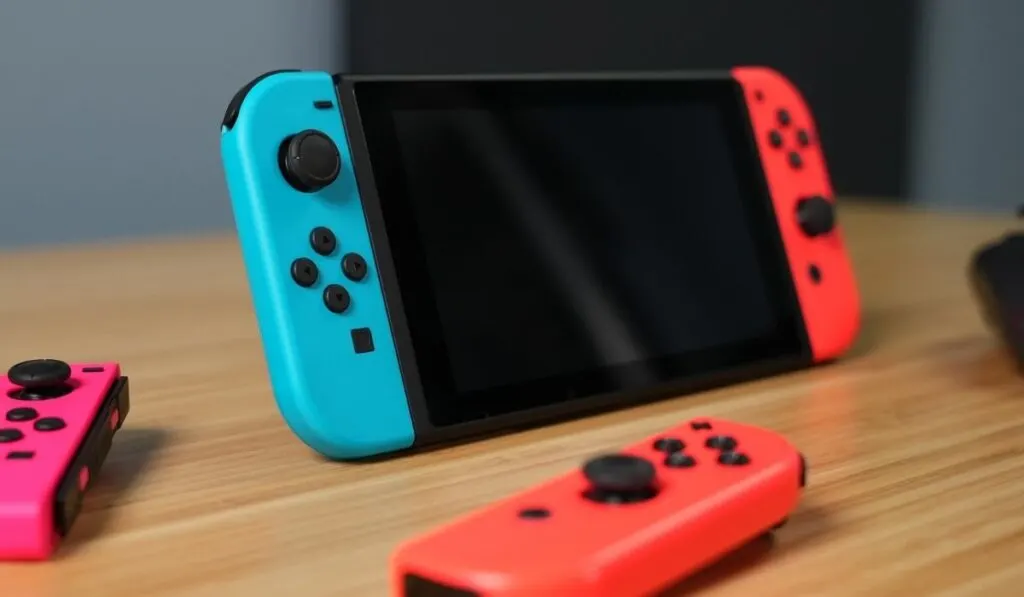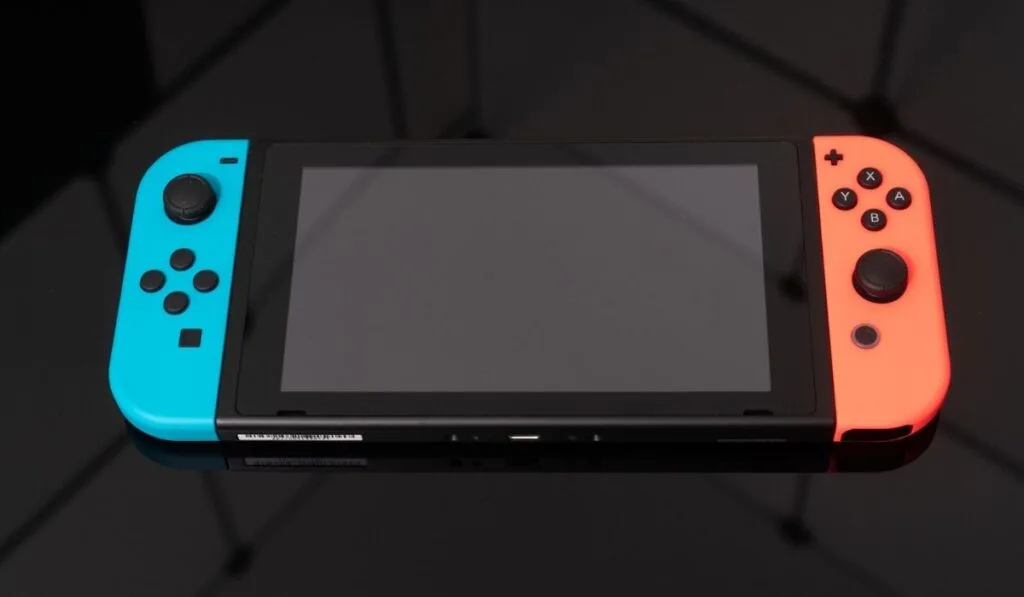The Nintendo Switch is a versatile console loved by gamers across the globe. However, that doesn’t mean the device isn’t without its fair share of issues. One common problem is black screens. So what gives?
A black screen on the Nintendo Switch can be caused by a drained battery, or maybe a damaged screen. You can resolve these issues by trying to charge your console, checking for damage on the screen, ports, or AC adapter, or even performing a manual “hard reset” after other options don’t work.
So don’t panic if your console is suffering from a black screen. This issue could be resolved with a bit of charging. We’ve compiled everything you need to know and the solutions available for a Nintendo Switch black screen.
Why Is Your Nintendo Switch Stuck on a Black Screen?

Does it get stuck on a black screen when you switch on your Nintendo Switch? Are there any charging indicators or lights? You’re not alone if you’re experiencing these issues. There are a few main reasons why a Nintendo Switch could get stuck or show a black screen.
Drained Battery
A drained or almost drained battery could be the reason behind a black screen on the Nintendo Switch. If the battery indicator appears briefly and then disappears, you may need to charge your console.
Damaged Screen
Like a smartphone or laptop, you may run across visual errors due to damage to the screen. For example, if you can hear sounds, the battery is fully charged, but the screen is entirely black, then you might have a damaged monitor. This is more likely If you recently dropped your Nintendo Switch or have a few cracks on the screen.
Damaged Dock or AC Adapter
A damaged Dock or AC adapter can also cause black screens and visual errors. Third-party docks and chargers are also known to cause glitches in rare cases.
Damaged Internals
Damaged internals to your Nintendo Switch can also cause black screens and errors. Failing electrical components can cause issues and might need to be replaced. The CPU might have been detached if you dropped your console, resulting in significant problems.
Software Issues
Software issues and bugs can cause black screens and errors in rare cases. Outdated patches and corrupted files are also known culprits of Nintendo Switch malfunctions.
How Do You Fix a Black Screen on Nintendo Switch?

Follow these troubleshooting methods below If your Nintendo Switch has a black screen, isn’t responsive, or won’t wake up.
Restart the Console
The first step of any troubleshooting process is to restart the device. Restarting the device gives your console a fresh start, solving any basic hiccups.
Here are the steps:
- Press and hold down the power button on your Nintendo Switch for 3-5 seconds.
- After that, choose Power Options and then select Restart.
- If your console isn’t responding whatsoever, you can forcefully shut down the device by holding the power button for 12 seconds. Afterward, press the power button to turn on the console.
Suppose this solved your performance issues, congratulations! Follow the steps below if you’re still experiencing black screens.
Inspect the AC Adapter
Inspecting and resetting the AC Adapter may resolve black screens and errors. So follow the steps below to begin.
- Unplug the AC adapter from the power outlet and console. Let it sit for at least 30 seconds.
- During this period, ensure you are using the official Nintendo AC adapter (model No. HAC-002).
- Inspect the AC adapter for cuts, kinks, or frayed cables. You may need to replace your AC adapter if you notice significant damage.
- After at least 30 seconds, reconnect the AC adapter to your Nintendo Switch and wall outlet.
- If you see a charging indicator on the home screen or a blank screen, allow the console to charge for 15 to 20 minutes. From there, ensure your console is using the latest software update.
If you don’t see any power or charging indicator on your Nintendo Switch, perform a hard reset by holding the Power Button down for 12 seconds. Then press it again to reboot the console. If you’re still experiencing difficulties, continue with the solutions below.
Hard-Reset the Nintendo Switch
Hard resetting your Nintendo Switch can alleviate a black screen. Keep in mind that this solution will delete all data except save data, screenshots, videos, and your information. Follow the steps below to begin.
- Forcefully shut down your Nintendo Switch following the steps above.
- Afterward, hold down both Volume up (+) and Volume Down (-). Press the power button to turn on the Switch.
- Keep holding down both Volume up and Volume Down to boot your Nintendo Switch in recovery mode.
- From the recovery mode screen, select “Factory Setting Without Deleting Save Data.”
This process will take some time but should help resolve any issues. Your save data, screenshots, and videos will remain intact, so there’s not much to worry about.
Update Your Switch
Software issues and outdated updates can sometimes cause black screens and malfunctions. Therefore, it’s best to ensure your Nintendo Switch is up to date and using the latest patch, ensuring there aren’t any bugs or glitches.
Here’s how to update your Nintendo Switch:
- From the Home menu, select System Settings
- The System Settings menu should appear.
- Scroll down on the left-hand menu and select System.
- On the right-hand side, select System Update.
Your Nintendo Switch should start updating if there’s an available patch. Follow any prompts necessary.
Check For Corrupted Data
Sometimes game files can become corrupted, resulting in performance issues and slow gameplay. You can check if your Nintendo Switch has any corrupted files by following the steps below:
- From the Home screen, select System Settings
- Use the left column to scroll down and choose Data Management
- Select Manage Software from the right side of the same menu
- Find the game you are having problems with
- Lastly, choose to Check for Corrupt Data
Undock or Dock Your Console
If you’re experiencing a black screen, you can try docking or undocking the console. Dock your device If you’re using the Nintendo Switch in handheld mode.
If you’re connected to the TV, try undocking the console. This will interrupt most of what’s going behind the scenes, giving your Switch a chance to readjust and return to normal.
Restore Factory Settings
This solution is your last resort. Restoring your Nintendo Switch to factory settings will cause you to lose all save data, screenshots, videos, and information. Here are the steps to factory reset your console.
- Forcefully shut down your Nintendo Switch following the steps above.
- Afterward, hold down both Volume up (+) and Volume Down (-). Press the power button to turn on the Switch.
- Keep holding down both Volume up and Volume Down to boot your Nintendo Switch in recovery mode.
- From the recovery mode screen, select “Restore Factory Settings.”
Remember, this will delete all your stored information and save data. So restoring your Nintendo Switch to factory settings should be a last resort.
Contact Nintendo Support
If none of the solutions above have resolved your issue, it may be time to send your console to Nintendo Switch support. You can contact Nintendo Switch support here.
Remember that sending your console for repairs may cause you to lose saved data, screenshots, or other information. And be sure to remove any game cards or microSD cards before sending your Nintendo Switch.
And watch out for more screen issues with your Switch – we have guides for everything you could run into: totally white screens (as opposed to black lol), lines on the screen, or the infamous orange or blue screens on the Switch or Switch Lite. If the screen flickers or gets too stretched out when docked, we have notes for those situations too, so be sure to bookmark us!
